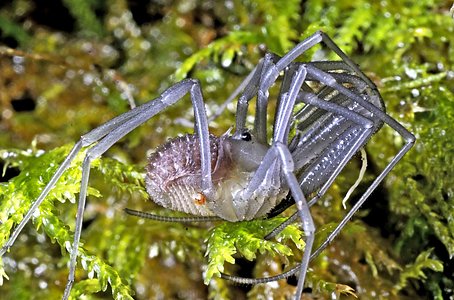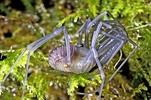Sabaconidae



This tree diagram shows the relationships between several groups of organisms.
The root of the current tree connects the organisms featured in this tree to their containing group and the rest of the Tree of Life. The basal branching point in the tree represents the ancestor of the other groups in the tree. This ancestor diversified over time into several descendent subgroups, which are represented as internal nodes and terminal taxa to the right.

You can click on the root to travel down the Tree of Life all the way to the root of all Life, and you can click on the names of descendent subgroups to travel up the Tree of Life all the way to individual species.
For more information on ToL tree formatting, please see Interpreting the Tree or Classification. To learn more about phylogenetic trees, please visit our Phylogenetic Biology pages.
close boxIntroduction
The current diagnosis of Sabaconidae lists autapomorphies of the included genera Hesperonemastoma, Sabacon and Taracus but features no morphological family characteristic (Giribet et al. 2010). Specialised bottlebrush hairs on the palps are shared between these genera within the Dyspnoi, but are found in unrelated Eupnoi groups, as well. For now this systematic is followed until a better definition becomes available. The group is very heterogeneous in genital and external morphology. Sabacon itself appears much more diverse than the remaining two genera. The family is Holarctic in distribution with all genera being present in North America.
Taxonomy and Discussion of Phylogenetic Relationships
The family concept is currently based on combined evidence of cladistic (Shear 1986) and molecular data (Giribet et al. 2010). The molecular data supports a close relationship of Hesperonemastoma and Taracus while their relationship with Sabacon receives weak support. This does not reassure the cladistic placement of Taracus closer to Sabacon (Shear 1986), but a placement of Hesperonemastoma in Ceratolasmatidae has to be rejected. Good family definitions of Sabaconidae and Ceratolasmatidae will have to await a revision of the Ischyropsalidoidea.
References
Giribet, G., Vogt, L. Pérez-González, A., Sharma, P. and A. B. Kury. 2010. A multilocus approach to harvestman (Arachnida: Opiliones) phylogeny with emphasis on biogeography and the systematics of Laniatores. Cladistics 26:408-437.
Shear, W. A. 1986. A cladistic analysis of the opilionid superfamily Ischyropsalidoidea, with description of the new family Ceratolasmatidae, the new genus Acuclavella and four new species. American Museum Novitates 2844:1-29.
Title Illustrations

| Scientific Name | Taracus sp |
|---|---|
| Specimen Condition | Live Specimen |
| Identified By | Axel Sch?nhofer |
| Life Cycle Stage | juvenile |
| Copyright |
© 2011 Axel Schönhofer

|
| Scientific Name | Sabacon viscayanum ramblaianum |
|---|---|
| Specimen Condition | Live Specimen |
| Identified By | Axel Schoenhofer |
| Sex | f |
| Life Cycle Stage | adult |
| Copyright |
© 2011 Axel Schönhofer

|
About This Page
Many thanks to Angela DiDomenico for the final English check.Page copyright © 2012
 Page: Tree of Life
Sabaconidae .
The TEXT of this page is licensed under the
Creative Commons Attribution-NonCommercial License - Version 3.0. Note that images and other media
featured on this page are each governed by their own license, and they may or may not be available
for reuse. Click on an image or a media link to access the media data window, which provides the
relevant licensing information. For the general terms and conditions of ToL material reuse and
redistribution, please see the Tree of Life Copyright
Policies.
Page: Tree of Life
Sabaconidae .
The TEXT of this page is licensed under the
Creative Commons Attribution-NonCommercial License - Version 3.0. Note that images and other media
featured on this page are each governed by their own license, and they may or may not be available
for reuse. Click on an image or a media link to access the media data window, which provides the
relevant licensing information. For the general terms and conditions of ToL material reuse and
redistribution, please see the Tree of Life Copyright
Policies.
- First online 08 July 2012
- Content changed 08 July 2012
Citing this page:
Tree of Life Web Project. 2012. Sabaconidae . Version 08 July 2012 (under construction). http://tolweb.org/Sabaconidae/60687/2012.07.08 in The Tree of Life Web Project, http://tolweb.org/







 Go to quick links
Go to quick search
Go to navigation for this section of the ToL site
Go to detailed links for the ToL site
Go to quick links
Go to quick search
Go to navigation for this section of the ToL site
Go to detailed links for the ToL site